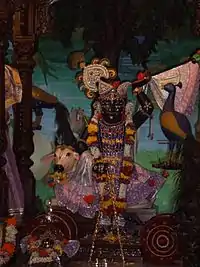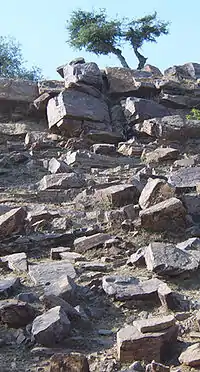Madhavendra Puri
Madhavendra Puri (Mādhavendra Purī in IAST) also known as Madhavendra Puri Goswami is a Vaishnava saint who appeared in the 14th century. He was initiated in to Dvaita Vedanta of Madhvacharya of Udupi region of Karnataka, was highly revered in Chaitanya Mahaprabhu's Gaudiya Vaishnavism
Madhavendra Puri | |
|---|---|
| Personal | |
| Religion | Hinduism |
| Order | Vedanta |
| Philosophy | Dvaita, Vaishnavism |
| Religious career | |
| Guru | Lakshmipati Tirtha |
Disciples
| |

Biography
Very little is known about the early years of Madhavendra Puri, as from the majority of sources he had already become a renunciant - a sannyasi. After making an extensive pilgrimage of India as a sannyasi he passed the remaining period of his life in Vrndavana and Orissa.[1] The main source of knowledge about this personality is Caitanya Caritamrita. What is known is that he was a sannyasi of the Madhva line being a disciple of Lakshmipati Tirtha and it appears that Madhavendra was the founder of the Vaishnava centre at Mathura, Vrindavana.

He is also famed for receiving direct instructions and gifts from the deity of Gopinatha, who commanded him to travel for the supply of scarce sandal wood paste from Orissa to the Malaya Mountains.[2]
Initiating sankirtana movement
Madhavendra Puri is often accepted as initial inspiration or initiator of the movement of Chaitanya Mahaprabhu,[3][4] who accepted Madhavendras intimate disciple, Isvara Puri as his diksa guru.[5] He is believed to have been preaching the principles of Gaudiya Vaishnavism prior to Caitanya.[6]
Service in separation
It is believed that Caitanya Mahaprabhu’s service in feelings of separation viraha begins with a single verse spoken by Madhavendra Puri, (his grand preceptor):[1]
"O, my beloved Lord, the friend of the afflicted! He Mathura-natha, when, when shall I see you? Without seeing you, my heart is perplexed, my beloved, and I am very restless! What am I to do?"[7]
Lineage
In accordance with Gaudiya Vaishnava sources he is believed to belong to the Madhvacharya lineage[8] that has been transcribed in books like Gaura-ganoddesa-dipika,[9] Prameya-ratnavali[10] and the writings of Gopala Guru Goswami. There is a version of this line of gurus recorded as a version found in the Gaura-ganoddesa-dipika[11] which matches other historical records.[12] He had many disciples but Advaita Acarya and Isvara Puri are believed to be the chief disciples of Madhavendra Puri.
The early History of the famous deity of Khirachora Gopinatha (Ksirachora Gopinath) is not given in Gaudiya texts – it is given by Vinod Bijaya Babaji in Gopinatha Caritamrta. However, there is a large account of his interactions with this Deity in Caitanya caritamrita, the foundational book for the Gaudiya Vaishnavas.
Memorial
| Part of a series on |
| Vaishnavism |
|---|
 |
|
|
Madhavendra Puri died in Remuna. His memorial Samādhi and sandals are still worshiped there.[13] It is a place of pilgrimage for many Vaishnava groups.
More information
- BB Teertha (2001). Chaitanya: His Life and Associates. Mandala Publishing. ISBN 1-886069-28-X.
- "Giriraj Swami — Lecture - Madhavendra Puri Disappearance day". www.rupa.com. Retrieved 22 April 2008.
- Hardy, Friedhelm - Madhavendra Puri: A Link Between Bengal Vaisnavism and South Indian Bhakti, JROS, no.1, 1974
- Kaviraja Goswami, Krishnadasa. "Madhavendra Puri - references in Caitanya caritamrta online". vedabase.net. Archived from the original on 19 March 2012. Retrieved 22 April 2008.
References and notes
- Chaitanya: His Life and Associates. Mandala Publishing. 2001. ISBN 1-886069-28-X.
- Page 36 Stuart Mark Elkman, Jīva Gosvāmī - 1986 “After being commanded by the deity to worship him with sandalwood from the South, Madhavendra set off for the Malaya Mountains”
- The Hare Krishnas in India — Page 46 Charles R. Brooks – 1992 “Some writers would even give Madhavendra Puri credit for initiating the movement which Chaitanya would eventually inspire”
- Kennedy, M.T. (1925). The Chaitanya Movement: A Study ofVaishnavism ofBengal. New York: Oxford University Press.
- History of Medieval Vaishnavism in Orissa — Mukherjee Prabhat 65 “Madhavendra puri is preceptor of Caitanya Mahaprabhus guru”
- Hare Krsna Movement: The Unifying Force of the Hindu Religion, Haripada Adhikary – 1995 Page 116
- ayi dIna-dayArdra nAtha he mathurA-nAtha kadAvalokyase hRdayaM tvad-aloka-kAtaraM dayita bhrAmyati kiM karomy aham
- "Madhavendra Puri". Krishna.com. Retrieved 26 September 2010.
- "Pocket-Size Sri Gaura-Ganoddesa-Dipika by Kavi Karnapura". store.naturalnirvana.com. Archived from the original on 19 March 2012. Retrieved 22 April 2008.
- Sri Prameya-ratnavali (The Jewel Necklace of Truths). 32pp. Rasbihari Lal & Sons 2009. ISBN 81-8403-060-6
- paravyomesvarasyasic chisyo brahma jagat-patih
tasya sisyo narado 'bhut vyasas tasyapa sisyatam
suko vyasasya sisyatvam prapto jnanavabodhanat
vyasal labdha-krsna-dikso madhvacaryo mahayasah
tasya sisyo naraharis tacchisyo madhava-dvijah
aksobhyas tasya sisyo 'bhut tac-chisyo jayatirthakah
tasya sisyo jnana-sindhus tasya sisyo mahanidhih
vidyanidhis tasya sisyo rajendras tasya sevakah
jayadharma munis tasya sisyo yad-gana-madhyatah
srimad-visnu-puri yas tu bhaktiratnavali-krtih
jayadharmasya sisyo 'bhud brahmanyah purusottahmah
vyasatirthas tasya sisyo yas cakre visnusamhitam
sriman laksmipatis tasya sisyo bhaktirasasrayah
tasya sisyo madhavendro yad-dharmo 'yam pravartitah
tasya sisyo 'bhavat sriman isvarakhya-puri-yatih
kalayamasa srngaram yah srngara-phalatmakah
advaitam kalayamasa dasya-sakhye phale ubhe
isvarakhya-purim-gaura urarikrtya gaurave
jagad aplavayamasa prakrtaprakrtatmakam
Brahma, the master of this universe, was the disciple of the Lord of the spiritual world. His disciple was Narada and Vyasa became the disciple of Narada. Suka became the disciple of Vyasa through the endowment of spiritual knowledge. Madhvacharya took initiation in the Krishna mantra from Vyasa. His disciple was Padmanabhacarya, whose disciple was Narahari, who was followed by Madhva Dvija. Akshobhya was his disciple, then Jayatirtha, Jnanasindhu, Mahanidhi, Vidyanidhi and Rajendra followed. Jayadharma Muni was one of Rajendra's many disciples and Vishnu Puri, the author of Bhakti-ratnavali and Purushottam, the lover of Brahmin culture became his disciples. Vyasa Tirtha, the author of Visnu-samhita, was the disciple of Purushottam. Lakshmipati Tirtha, a reservoir of devotion, was Vyasa Tirtha's disciple. Madhavendra Puri was the disciple of Lakshmipati, and it is by him that the religion was founded. His disciple, the sannyasi Ishvara Puri, took up the mood of conjugal devotion, while Advaita Acharya (also the disciple of Madhavendra) took up the moods of servitude and friendship. Gaura accepted Ishvara Puri as his guru, and then flooded the material and spiritual worlds (with love). - The same set of verses is found with some slight differences in the Bhakti-ratnakara (5.2549-2162).
- Mukherjee, P. (1940). The History of Medieval Vaishnavism in Orissa. R. Chatterjee. ISBN 81-206-0229-3.p. 66
